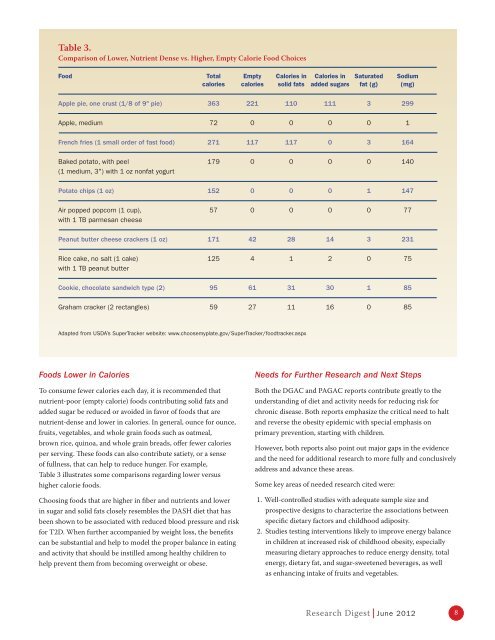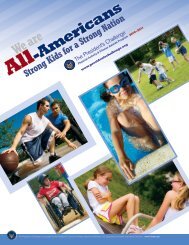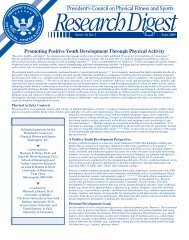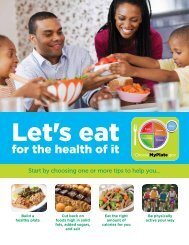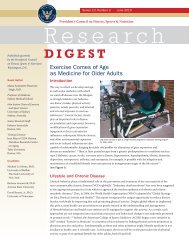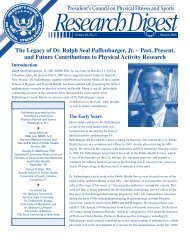Combining the U.S. Dietary Guidelines and Physical Activity
Combining the U.S. Dietary Guidelines and Physical Activity
Combining the U.S. Dietary Guidelines and Physical Activity
Create successful ePaper yourself
Turn your PDF publications into a flip-book with our unique Google optimized e-Paper software.
Table 3.<br />
Comparison of Lower, Nutrient Dense vs. Higher, Empty Calorie Food Choices<br />
Food Total Empty Calories in Calories in Saturated Sodium<br />
calories calories solid fats added sugars fat (g) (mg)<br />
Apple pie, one crust (1/8 of 9" pie) 363 221 110 111 3 299<br />
Apple, medium 72 0 0 0 0 1<br />
French fries (1 small order of fast food) 271 117 117 0 3 164<br />
Baked potato, with peel 179 0 0 0 0 140<br />
(1 medium, 3") with 1 oz nonfat yogurt<br />
Potato chips (1 oz) 152 0 0 0 1 147<br />
Air popped popcorn (1 cup), 57 0 0 0 0 77<br />
with 1 TB parmesan cheese<br />
Peanut butter cheese crackers (1 oz) 171 42 28 14 3 231<br />
Rice cake, no salt (1 cake) 125 4 1 2 0 75<br />
with 1 TB peanut butter<br />
Cookie, chocolate s<strong>and</strong>wich type (2) 95 61 31 30 1 85<br />
Graham cracker (2 rectangles) 59 27 11 16 0 85<br />
Adapted from USDA’s SuperTracker website: www.choosemyplate.gov/SuperTracker/foodtracker.aspx<br />
Foods Lower in Calories<br />
To consume fewer calories each day, it is recommended that<br />
nutrient-poor (empty calorie) foods contributing solid fats <strong>and</strong><br />
added sugar be reduced or avoided in favor of foods that are<br />
nutrient-dense <strong>and</strong> lower in calories. In general, ounce for ounce,<br />
fruits, vegetables, <strong>and</strong> whole grain foods such as oatmeal,<br />
brown rice, quinoa, <strong>and</strong> whole grain breads, offer fewer calories<br />
per serving. These foods can also contribute satiety, or a sense<br />
of fullness, that can help to reduce hunger. For example,<br />
Table 3 illustrates some comparisons regarding lower versus<br />
higher calorie foods.<br />
Choosing foods that are higher in fiber <strong>and</strong> nutrients <strong>and</strong> lower<br />
in sugar <strong>and</strong> solid fats closely resembles <strong>the</strong> DASH diet that has<br />
been shown to be associated with reduced blood pressure <strong>and</strong> risk<br />
for T2D. When fur<strong>the</strong>r accompanied by weight loss, <strong>the</strong> benefits<br />
can be substantial <strong>and</strong> help to model <strong>the</strong> proper balance in eating<br />
<strong>and</strong> activity that should be instilled among healthy children to<br />
help prevent <strong>the</strong>m from becoming overweight or obese.<br />
Needs for Fur<strong>the</strong>r Research <strong>and</strong> Next Steps<br />
Both <strong>the</strong> DGAC <strong>and</strong> PAGAC reports contribute greatly to <strong>the</strong><br />
underst<strong>and</strong>ing of diet <strong>and</strong> activity needs for reducing risk for<br />
chronic disease. Both reports emphasize <strong>the</strong> critical need to halt<br />
<strong>and</strong> reverse <strong>the</strong> obesity epidemic with special emphasis on<br />
primary prevention, starting with children.<br />
However, both reports also point out major gaps in <strong>the</strong> evidence<br />
<strong>and</strong> <strong>the</strong> need for additional research to more fully <strong>and</strong> conclusively<br />
address <strong>and</strong> advance <strong>the</strong>se areas.<br />
Some key areas of needed research cited were:<br />
1. Well-controlled studies with adequate sample size <strong>and</strong><br />
prospective designs to characterize <strong>the</strong> associations between<br />
specific dietary factors <strong>and</strong> childhood adiposity.<br />
2. Studies testing interventions likely to improve energy balance<br />
in children at increased risk of childhood obesity, especially<br />
measuring dietary approaches to reduce energy density, total<br />
energy, dietary fat, <strong>and</strong> sugar-sweetened beverages, as well<br />
as enhancing intake of fruits <strong>and</strong> vegetables.<br />
Research Digest June 2012<br />
8


